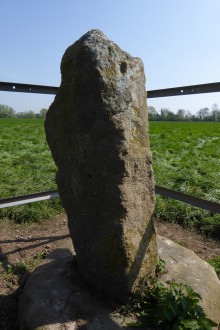|
|
|
|
Wergins StoneStanding Stone / Menhir
|
||||||||||||||||||||||||
|
|
|
Images (click to view fullsize) |
|








|
Fieldnotes |
|
|
Visited 22.3.13 Directions: Take the A49 north, out of Hereford, and then the minor road on the right signposts Moreton On Lugg then Sutton St Nicholas. When you enter the village of Sutton St Nicholas turn right (south) at the cross roads. Shortly after crossing the bridge the stone is easily visible in a field to your left. It has been a long time since I ‘hugged a stone’ and I was looking forward to visiting this site. Unfortunately I had to settle for a view from the road. Between the road and the stone is a ditch which presumably is there to assist with field drainage? Due to the wet weather the ditch was now a small stream – too deep to wade through / too wide to jump across. However, the stone is easily seen from road and has a small metal fence surrounding it to protect it from farm machinery etc. Which I guess is something to be applauded. Pity I couldn’t get to touch it though…………….. |
Posted by CARL 23rd March 2013ce |
| A stop-off after a visit to Sutton Walls (28.1.2010). The stone is in a field alongside the River Lugg next to a busy B-road. It is cut off from the road by a deep drainage ditch and has been surrounded by an unsightly box-like fence. Not very welcoming sadly, perhaps I'll come again for a proper look when it's not raining! |
 Posted by thesweetcheat
Posted by thesweetcheat28th January 2010ce Edited 28th January 2010ce |
Folklore |
|
Strange Newes From Hereford.From an appendix in Memorials of the Civil War by the Rev T W Webb (v2), 1879. Apparently this strange incident was seen as one of a number of strange portents 'attended to with intense interest and dread' that occurred in the period leading up to the war, as the Rev explains here. |
 Posted by Rhiannon
Posted by Rhiannon8th August 2013ce Edited 8th August 2013ce |
A slight variation/addition to the folklore:"at noon on Wednesday 16th February 1642 an extraordinarily strong wind dragged the upright Wergins Stone 120 yards away, making an 18" dent in the ground the whole distance, and carried the base stone 440 yards away through the air; a satanic black dog was seen running before one of the stones"From "Stone Spotting In Herefordshire" - Jonathan Sant (2000 Moondial), referring to "Civil War in Herefordshire" - John Webb (1879) |
 Posted by thesweetcheat
Posted by thesweetcheat7th January 2009ce Edited 9th August 2017ce |
|
This stone is nearly 5ft high and stands (according to the Herefordshire SMR) in a pentagonal base - maybe a cross base. But they do say it's prehistoric. Bar the cross base. Gough's 1806 'Camden' mentions two stones, perhaps the remains of a cromlech. The meadow where they were was called 'Wergins', hence the name. An alternative title - the Devil's Stone - comes from a strange incident in the 17th century: Between Sutton and Hereford, is a common meadow call'd the Wergins, where were plac'd two large stones for a watermark; one erected upright, and the other laid a-thwart. In the late Civil Wars, about the Year 1652, they were remov'd to about twelve score paces distance, and no body knew how; which gave occasion to a common opinion, That they were carried thither by the Devil. When they were set in their places again, one of them requir'd nine yoke of oxen to draw it.from Daniel Defoe's 1720s 'Tour Through the Whole Island of Great Britain' (excerpt online at 'A Vision of Britain Through Time' http://www.visionofbritain.org.uk/Travellers/contents_page.jsp?t_id=Defoe_2&cpub_ID=0 The stone is right by the road, according to the OS map, so barring any hedges you might be able to see it from the comfort of your car. |
 Posted by Rhiannon
Posted by Rhiannon1st June 2005ce Edited 1st June 2005ce |
Links |
|
Sacred TextsAlfred Watkins thought the Wergins Stone (top right in the picture) was an ancient marker, the flat face pointing out the direction of a 'ley'. This photo is part of his 'Early British Trackways' book, online at the Sacred Texts archive. |
 Posted by Rhiannon
Posted by Rhiannon1st June 2005ce |

